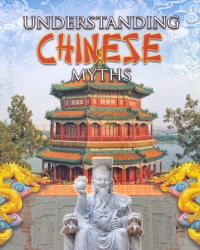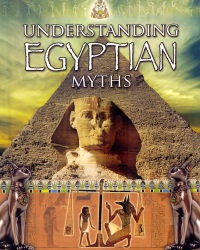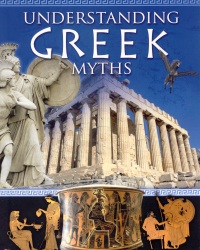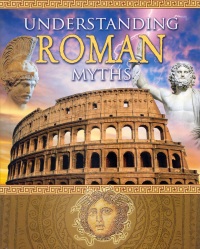| ________________
CM . . .
. Volume 19 Number 10 . . . . November 9, 2012
excerpt:
Four titles comprise the new "Myths Understood" series whose basic premise is that, in order to understand the myths of a particular culture or society, one must first understand the times and the settings in which they were told or written. Each of the titles has seven similar chapter headings and begins with a general definition of what myths are- a written or spoken narrative which helped people to explain the unknown, the natural world (such as the reasons for seasons, weather, or the origins of the stars and planets, and plants and animals) and tragic events, such as floods and earthquakes. Myths also set standards for behaviour. Following the introductory chapter, the remainder of each book covers the featured country in ancient times, its religion and gods, the natural world, daily life and classes of people, trade and warfare, and the modern-day legacy of an ancient culture. Interspersed throughout the text are related myths. In fact, there is actually far greater emphasis on the influence of the specific culture on the myths than on the myths themselves. A time chart, a table of contents, a glossary, and an index are provided, along with a list of books, web sites and DVDs for further research. The text provides the background for the myths in each chapter. For example, in the title about Greek myths, the topic of agriculture is matched with a related myth about Demeter, goddess of the harvest. Unfortunately, the main body of the text and the texts of the myths seem to be slightly disparate, with the former more interesting and well-written than the latter which are rather flat and lifeless and not as fluent. In fact, the myths read more like brief summaries than actual stories. Some of them have a long list of characters, while others are only very loosely related to the topic in the main body of the text. There are several text boxes which provide additional information as well as "Link to Today" boxes which demonstrate the culture’s influence on present-day life. A few examples are the pyramid shapes from ancient Egypt being copied for modern structures, such as the Louvre Pyramid in Paris and the Goja Music Hall in Prague; FTD florists’ use of Hermes, the winged messenger god of ancient Greece, as its symbol for worldwide floral delivery; and the ancient Chinese art of object placement and balance- feng shui- which has gained in popularity in recent years. Illustrations are many and varied, ranging from maps and photographs to ancient drawings and paintings rendered in various media. Photos of woodcuts, murals, mosaics, statues and ancient writings carved in stone add authenticity to the text. In the Chinese language, the word "myth" is called a "shen-hua", or sacred story, which was spread by word of mouth. Though these myths have undergone many changes in their telling over tens of thousands of years, they became more consistent when, at last, they were written down in ancient texts during the Age of Philosophers from 600 to 100 B.C.E. Today’s books and movies have been influenced by some of the characters and tales, some examples being author Amy Tan’s The Joy Luck Club, which draws on Chinese mythical and family traditions, and the Disney movie, Mulan, which is based on a Chinese mythical character of a female warrior. Understanding Chinese Myths transports readers to ancient China where a succession of dynasties and emperors ruled the country and where Taoism, Buddhism and Confucianism influenced the beliefs of the people. There are six different creation myths, one of which speaks of Pan Gu who formed heaven and Earth. The concept of yin and yang, perfect opposites that cannot exist without one another, is central to this myth. Among others, themes in Chinese myths include immortality, metamorphosis, natural landforms (the power of mountains, for instance), astronomy, and moral ethics (honor, obedience and respect, to name a few). Even today, people are aware of the symbolism of the 12 animals in the Chinese zodiac which is based on a story about the Buddha. The text provides the background for the myths in each chapter. For example, in the title about Greek myths, the topic of agriculture is matched with a related myth about Demeter, goddess of the harvest. Unfortunately, the main body of the text and the texts of the myths seem to be slightly disparate, with the former more interesting and well-written than the latter which are rather flat and lifeless and not as fluent. In fact, the myths read more like brief summaries than actual stories. Some of them have a long list of characters, while others are only very loosely related to the topic in the main body of the text. There are several text boxes which provide additional information as well as "Link to Today" boxes which demonstrate the culture’s influence on present-day life. A few examples are the pyramid shapes from ancient Egypt being copied for modern structures, such as the Louvre Pyramid in Paris and the Goja Music Hall in Prague; FTD florists’ use of Hermes, the winged messenger god of ancient Greece, as its symbol for worldwide floral delivery; and the ancient Chinese art of object placement and balance- feng shui- which has gained in popularity in recent years. Though there are fewer complete myths from ancient Egypt than other ancient cultures, the pieces that have survived, coupled with the stories told in hieroglyphs, offer a glimpse into Egyptian life and beliefs. Understanding Egyptian Myths explains that ancient Egyptians believed that the gods were involved in all aspects of the lives of all people, whether kings or slaves. The people worshiped their gods to ensure that the sun rose every day, their crops were looked after and that there was order and balance in their world. Their belief in the afterlife was the reason for building pyramids and mummifying bodies. In Egyptian myths, the gods, which numbered in the hundreds, behaved like humans but had special roles and powers. Some regions of Egypt had their own gods, but some gods were worshiped by all Egyptians. Ra, the sun god and creator of everything, was the most powerful. Other gods and goddesses included Sekhmet, the lion-headed goddess of war, Osiris, the god of fertility, who was often depicted with green skin, symbolizing vegetation and growth, and the mother goddess, Isis, whose magic was extremely powerful. The story of the Lion and the Mouse, with which most young children are familiar, originated from a myth about the god Thoth. Its message is that the small and weak can often come to the aid of the strong and mighty, while the Egyptian version of the Cinderella story, about a young woman named Rhodopis, is not only a myth about kindness and goodness triumphing over evil, but it also demonstrates to readers that harmony and respect existed between the classes in ancient Egypt. Other influences of Egyptian mythology can be seen in movies, such as Night at the Museum and Raiders of the Lost Ark, jewellery designs such as the scarab beetle and the eye of Horus, buildings such as the Luxor Hotel in Las Vegas and the obelisk-shaped Washington Monument, and video games, such as Tomb Raider, Immortal Cities: Children of the Nile. In ancient Greece, there were two main types of myths: creation myths, which described how the world, plants and animals, and people originated, and morality myths, which provided guiding principles for human behaviour and threatened punishment for those who failed to abide by the rules. Common themes included heroes’ quests, fate, love and beauty, and goodness and generosity versus evil and greed. Some myths were found in the epic poems of Homer. Others were told by travelers and merchants from different regions and cultures, but gradually the myths’ characters were blended into the gods and goddesses that are known today. Understanding Greek Myths explains that there were different classes of gods. Zeus was the father of all gods and men and ruled the universe. Other well-known gods were Poseidon, god of the sea, Hades, god of the underworld, and Helios, god of the sun. Readers will recognize the name "Nike", the goddess of victory, known for her speed, and for whom the athletic company, Nike, is named. And older readers might even begin to associate the names of some of the gods and goddesses with some words that are frequently used nowadays, for example, the word "hypnotize" after Hypnos, god of sleep. Some of the other topics in this title include the rivalry between the city-states of Sparta and Athens, the oracle of Delphi, ancient Greek temples, daily life in a Greek household, sports and entertainment, festivals, and the Trojan War. The contributions of ancient Greek myths to modern society are many. Some of these are the Olympic flame, representing the fire that Prometheus stole from Zeus to give to humans, the astrological zodiac, of which all 12 constellations can trace their meanings back to early Greek mythology, and the Muses, goddesses of music, dance, literature, theater, history and astronomy (the muses of comedy and tragedy are frequently shown in theatres as smiling and frowning masks). Generally, the titles in this series do a good job of painting a picture of ancient societies for readers, but some of the myths, themselves, require a bit of revision. Recommended. Gail Hamilton is a former teacher-librarian in Winnipeg, MB.
To comment on this
title or this review, send mail to cm@umanitoba.ca.
Copyright © the Manitoba Library Association. Reproduction for personal
use is permitted only if this copyright notice is maintained. Any
other reproduction is prohibited without permission.
NEXT REVIEW |
TABLE OF CONTENTS FOR THIS ISSUE
- November 9, 2012. AUTHORS
| TITLES | MEDIA REVIEWS
| PROFILES
| BACK ISSUES
| SEARCH | CMARCHIVE
| HOME |



